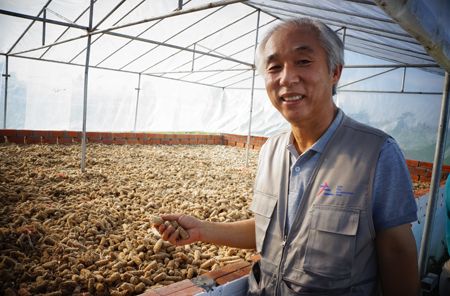Korean professor uses ‘ondol’ to help Cambodians

National Polytechnic Institute of Cambodia professor Kim Man-gab shows corn cobs on a dryer he invented in Battambang, the leading rice-producing province of Cambodia, on Oct. 10. / Korea Times photo by Kim Da-ye
BATTAMBANG, Cambodia — The mercury hardly drops below 30 degrees Celsius in the daytime throughout the year in Cambodia, but vegetables and fruits dry slow even under the blazing sun and often go bad. Kim Man-gab, a professor at the National Polytechnic Institute of Cambodia, wondered why.
Kim eventually discovered that humidity had a lot to do with this; the wet season lasts from May to October. Generally dried vegetables and fruits are priced higher than fresh ones and can also be easily exported. Kim believed an invention that speeded up the drying process held the potential to address Cambodia’s chronic poverty.
“There are merchants from all over the world lining up to buy Cambodian agricultural products if they are dried,” he said during an interview.
A professor of architecture, Kim came up with a very Korean invention. He created a dryer based on an “ondol,” the Korean floor heating system, which is easy to build and maintain. Resembling a small brick cabin with a chimney, the system has a furnace at the bottom and a large flat surface on the top that stays warm. A plastic canopy above it protects the dried crops from rain.
Kim came to Phnom Pehn, the capital of Cambodia, in March 2011. A devout Christian and formerly a senior official at the Daejeon Metropolitan City hall, he moved to Cambodia with the goal of contributing to fighting the country’s poverty.
Before Cambodia, he lived in Mongolia for three years where he invented a G-Saver, a 20-liter-large heat retainer that lasted longer and emitted fewer exhaust fumes.
Kim, who still maintains his tenure at the Mongolian University of Science and Technology because of his contribution to the country, had to leave because of the country’s cold climate that exacerbated complications from a dental condition he developed whilst living there.
His early days in Cambodia, were characterized by uncertainties over whether the country needed him.
Unlike Mongolia, where hostile conditions could freeze people and livestock, in addition to adding to the general food scarcity, Cambodia’s tropical climate was just right for cultivating crops.
Kim soon came out with multiple innovative ideas to help the Cambodians. He is an expert in appropriate technology, which is user-friendly, eco-friendly and suits the local’s needs. In 2011, with funding from ASEM SMEs Eco-Innovation Center (ASEIC), he created incinerators after seeing trash littered everywhere.
ASEIC is a non-profit body backed by Asian and European heads of state to promote green growth among small- and medium-sized enterprises (SMEs).
This year, ASEIC supported him with funding of 30 million won, which was used to develop dryers out of the basic structure of the incinerator.
Next to the dryers, he made a pit where corn cobs — burned to warm up the dryers — are mixed with microorganisms and fermented into fertilizer.
During his next visit to Korea, he plans to visit a green tea farm in Goseong, South Gyeongsang Province, to observe how tea leaves are dried with the hope of replicating similar know-how in Cambodia for drying herbs.
His invention is the product of constant experimentation and innovation. One principle he sticks to is following local wisdom.
For example, many Korean non-governmental organizations dug wells in Cambodia unaware that the underground water contained harmful heavy metals including arsenic.
All Cambodian households have giant pots in their front yards to collect rainwater.
“The locals have their distinctive way of doing things, which have to be respected,” Kim said.
After the ASEIC project ends, he plans to set up an appropriate technology center and hire returning Cambodians from Korea. He is working on a small Korean-English-Cambodian dictionary on architecture, which contains 1,500 words.
The professor does not plan to live in Cambodia for long. “Cambodia is developing too fast. In three to five years, I and my inventions will no longer be in much need. And I fear settling for the present,” he said.
His most likely destination will be Myanmar, Cambodia’s relatively isolated neighbor. There are some 8,000 NGOs in Cambodia because of its easy accessibility.
“I learned much and lived well in Korea. I wanted to share the blessings with others,” Kim said.
“I wonder if I could be this happy in Korea. I don’t think I felt as fulfilled as I am now in Cambodia.” <The Korea Times/Kim Da-ye>





















































